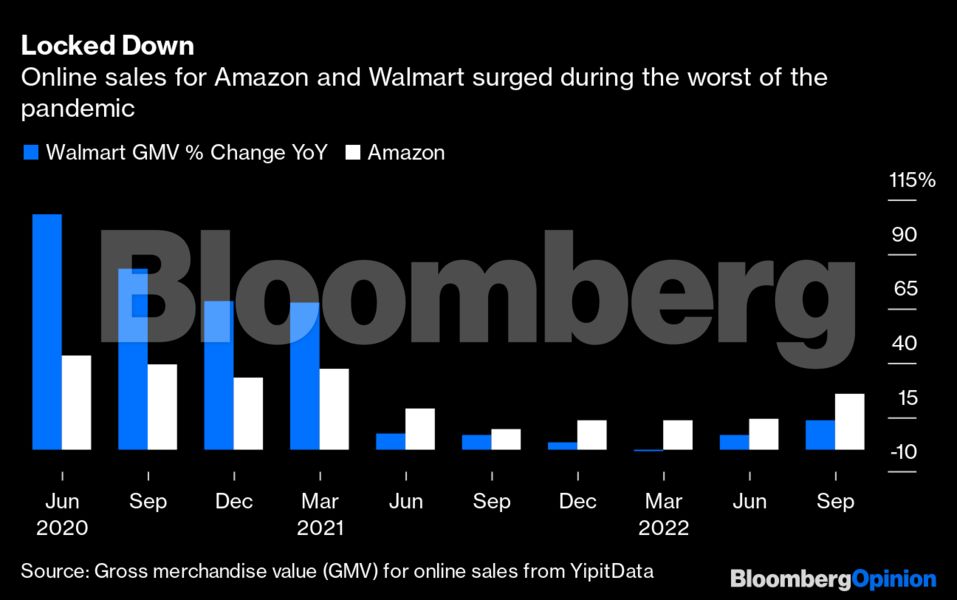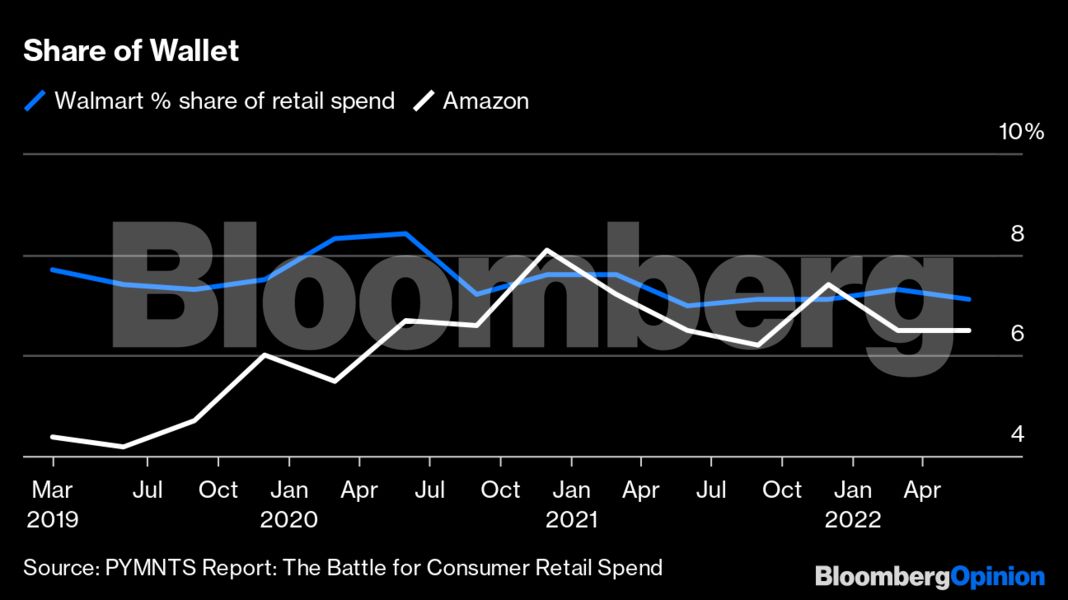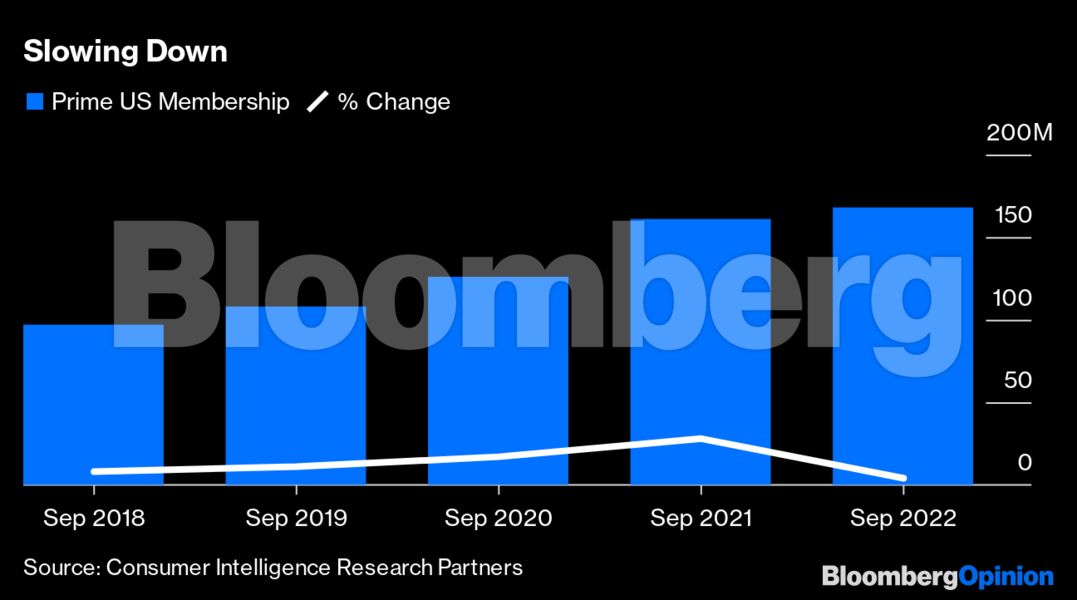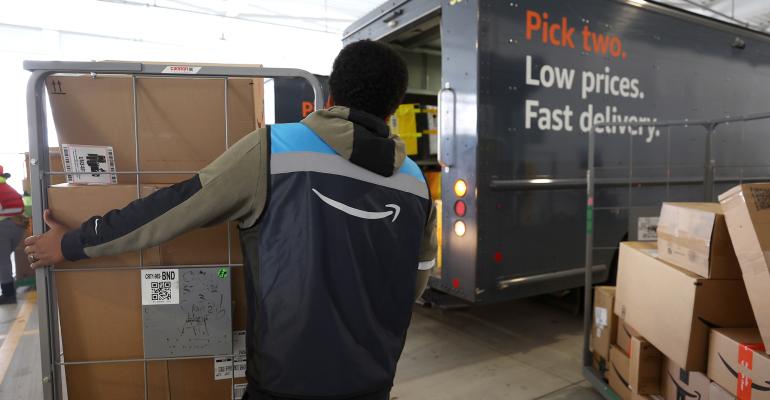(Bloomberg Opinion) -- Amazon.com Inc.’s founder has long been obsessed with the company’s beginning — and its end.
In 2013, Jeff Bezos told 60 Minutes that companies have short life spans, “even the shiniest and most important of any era.” In his final letter to shareholders as CEO in 2021, with Amazon valued at more than $1.5 trillion, he quoted a book by evolutionary biologist Richard Dawkins to suggest that the e-commerce giant is in a constant state of “staving off death.”
The idea seemed absurd in the middle of the pandemic. Amazon’s online sales had exploded as people avoided stores. Restless consumers, buoyed by stimulus payments, were on a shopping spree. Between 2019 and 2021, Amazon’s online store sales grew 57% to more than $222 billion; subscription sales, which include its prized members’ service Prime, surged 65%; and its share of consumer retail spending surged to overtake it biggest rival, Walmart Inc. It became more of a utility in consumers’ minds than an online store. What would we have done without online delivery? Without Amazon?
At the same time, retailers that had been lagging behind in e-commerce were forced to catch up — and fast. Nearly everyone from luxury names to department stores ramped up online. Walmart, for one, expanded its online assortment, opened its marketplace to international sellers, rolled out curbside and in-store pick up, and ramped up online order fulfillment out of its stores. In the first nine months of the pandemic, its online sales grew at twice the rate of Amazon’s, albeit off a far smaller base, according to data from retail technology research firm YipitData.

Fast forward to today and Amazon no longer seems unassailable. This year saw the world’s largest e-commerce company at one point lose a trillion dollars in market value as growth in online shopping slowed sharply and its forecast for the all-important holiday quarter disappointed. Prime memberships have flat-lined following the pandemic surge. And the firm is in the midst of its biggest-ever employee cull, targeting about 10,000 jobs across the devices and retail businesses.
Inflation-squeezed shoppers are more cautious about what they do with their wallets, and less willing to spend on novelties like $20 for an avocado chopper or $25 for a few wands that remove histamines from a glass of wine. Instead of impulse buys, people are spending more on groceries and other necessities — Walmart’s sweet spot. Amazon’s prices are still generally cheaper than Walmart, but Walmart does price matching all year around and its annual Walmart+ membership of $99 compares with $139 for Prime. With some back of the napkin math, a pack of toilet paper may end up cheaper to buy from Walmart than Amazon.
The dramatic shift in sentiment coupled with more aggressive online competition have seen Amazon fall back in the battle for consumers’ wallets as Walmart leverages its advantage as the country’s largest grocery store. So long as we’re in an inflationary environment, Walmart’s lead in groceries and Prime’s increased cost put Amazon on the back foot, according to Tom Forte, a senior research analyst with D.A. Davidson. Research firm Insider Intelligence estimates that the brick-and-mortar giant will generate roughly $39 billion in online grocery sales this year, and widen its lead over Amazon through 2024.

Part of it is that many consumers prefer to pick up recurring grocery orders at a store rather than pay a delivery fee or surcharge — a clear advantage for Walmart with stores a short drive from 90% of Americans. Amazon and its Whole Foods unit also offer a narrower selection of food and household supplies available for delivery than Walmart. And despite the fear and optimism in the industry that followed Amazon’s purchase of Whole Foods in 2017, the e-commerce giant has yet to get the hang of running physical stores.
More broadly, Amazon’s predominantly online retail business is on the wrong side of consumer behavior. After two years of pandemic restrictions, people are eager to get back out to physical stores, many of which have dramatically reconfigured their spaces to better serve customers.
Target Corp. and Walmart have refocused part of their store operations toward online fulfillment, turning some areas into packing spaces or order pick-up spots. Shoppers on their way out might stop for a tube of toothpaste or something else from Target’s dollar spot. Businesses from Aldi to Foot Locker Inc. added self-checkout stands and tap-and-go smartphone payments to keep stores sanitary with contactless systems. The more dollars people spend in stores, the fewer they spend with Amazon.
That said, Amazon can only grow as much as e-commerce spending, as Juozas Kaziukenas, CEO of the e-commerce data intelligence firm Marketplace Pulse, points out. E-commerce sales have hovered around 14% of overall retail sales for the last 18 months, mid-way between a pandemic peak and the pre-pandemic level, Census Bureau data show. Even Amazon’s crown-jewel Prime is showing signs of stagnation, growing only 5% between 2021 and 2022, according to Consumer Intelligence Research Partners. With an estimated 168 million members in the US, Amazon has little choice but to seek growth among consumers in China, India and Mexico, where it has run into a slew of competition.

In its e-commerce stronghold, Amazon finds itself in the unusual position of chasing innovation. This month, it launched Inspire, a TikTok-style service that will let shoppers buy merchandise from a curated feed of photos and video, playing catch up in the social commerce space along with Alphabet Inc.’s Google and Meta Platforms Inc.’s Facebook and Instagram. Here, TikTok has the natural advantage, tracing a path already laid by sister-app Douyin in China.
It’s no secret Amazon’s competitive edge is that it’s more technology company than retailer. Its 2021 operating income from Amazon Web Services, the company’s cloud platform, at $18.5 billion was more than double its North America retail business at $7.3 billion. Amazon has had more “retail” success as an online advertiser or landlord than selling things itself. More than half of its online sales were made by third-party sellers, which are small businesses that pay to sell on Amazon’s site. In running a marketplace where third-party sellers do the grunt work of selling goods online, Amazon mainly collects fees to advertise, store and deliver their stuff — a $103 billion business.
When it comes to the world of pureplay retail, Amazon may well be making the transition from disruptor to disrupted that Bezos has long warned of. Not many retailers are lucky enough to avoid that fate for more than a few decades. Iconic names including Sears, JCPenney, Neiman Marcus Group and Lord & Taylor have all filed for bankruptcy over the last few years and emerged in a smaller or tattered form. Sears Hometown Stores Inc., an affiliate of Sears, filed for bankruptcy this week. The retail industry is ruthlessly competitive, and as fickle consumers are offered more options than ever, even giants like Amazon can lose their footing.
Still, it’s difficult to imagine what retail would be like without Amazon’s influence. Amazon is synonymous with online shopping. Years after it found success pitting third-party vendors against each other on the marketplace to drive down prices, Walmart and others followed. Amazon re-imagined what store membership could look like with Prime. Before Amazon, one- and two-day delivery was unheard of. Now it’s just a part of shopping on the internet.
It’s unclear whether 2022 will go down in Amazon’s history as a blip or the beginning of its slide into the ranks of its retail peers. Brian Oslavsky, Amazon’s chief financial officer, has told investors that Amazon’s moderating sales growth is partially due to tightening consumer wallets and the business “normalizing” after a period of skyrocketing sales. Either way, Amazon has written the rules of modern retail. The question now is whether it can keep winning at its own game.
To contact the author of this story: Leticia Miranda at [email protected]
© 2022 Bloomberg L.P.




